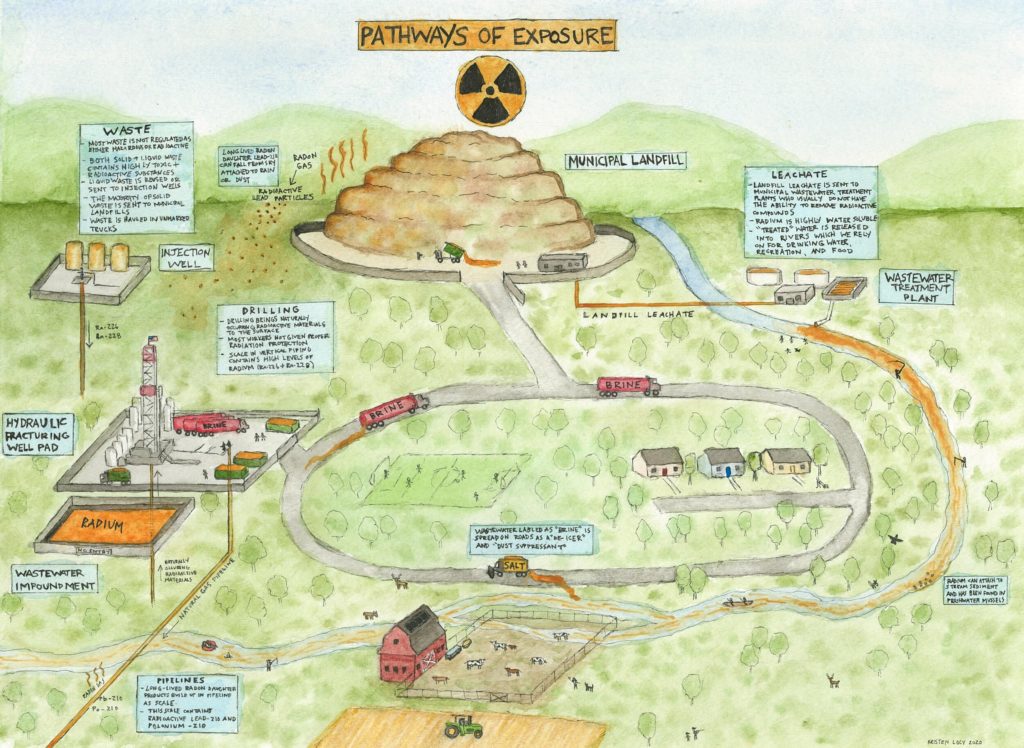
Source: Kristen Locy. See also Kristen’s blog on Radiation and Fracking here.
Key words:
Centralized Waste Treatment Facility (CWT): a facility that treats or recovers hazardous or non-hazardous industrial metal-bearing waste, oily waste, and organic- bearing waste from off-site
Half-life: the time it takes for one-half of the atoms of a radioactive material to disintegrate
Isotope: chemical element with the same atomic number and position in the periodic table and nearly identical chemical behaviour but with different atomic masses and physical properties. Ex: Radium-226 and Radium-228
Ionize: when an atom acquires a negative or positive charge by gaining or losing electrons to form ions, which then releases energy. The spontaneous disintegration of atoms is called radioactivity, and the excess energy emitted is a form of ionizing radiation
Leachate: landfill leachate is a liquid formed when rainwater infiltrates and percolates through the waste in a landfill
Naturally Occurring Radioactive Material (NORM): is any radioactive material present in water, soils, rocks, and materials not disturbed by human activity
Picocurie (pCi): a very small amount of radioactivity, associated with about a trillionth of a gram (a picogram) of radium. Typically measured in pCi/g or pCi/L
Sievert (Sv): measures human exposure to radiation. It takes into account the amount of radiation over a certain amount of time and the type of radiation
Technically Enhanced Naturally Occurring Radioactive Material (TENORM): is naturally occurring radioactive material where the natural radionuclide concentrations are increased by or as a result of human practices. Typical TENORM materials include materials such as gas plant pipe scaling, some drinking water purification and treatment wastes, mining/refining wastes, scrap metal, industrial sludges, and other industrial process, wastes and materials
Radium-226: made from the decay of Uranium-238. Alpha and gamma emitter. Half-life of 1600 years. Decays to Radon-222 (called a daughter product). Eventually decays to stable Lead-206. Radium is water-soluble. Radium is a “bone seeker” and concentrates in bones if exposed. Radium exposure can lead to various cancers, including bone cancer
Radium-228: made from the decay of Thorium-232. Beta emitter. Half life is 5.75 years. Decays to Thorium-228. Half-life 1.9 years. Eventually decays to stable Lead-208
Radon: Naturally occurring radioactive gas from the breakdown of uranium, thorium, or radium in the rocks and soil. The two most significant isotopes in the human environment are Radon-222 (daughter of Radium-226) and Radon-220 (daughter of Radium-228). Alpha emitter. Eventually decays to lead. Radon inhalation is the second leading cause of lung cancer in the US. Radon decaying to lead poses another threat from ingestion or inhalation of particles
Roentgen: Is the measurement of energy produced by Gamma or X-Ray radiation in a cubic centimeter of air. It is abbreviated with the capital “R”. One milliroentgen, abbreviated “mR” is one-thousandth of a roentgen. One microroentgen, abbreviated “uR” is one-millionth of a roentgen.
Radioactivity 101
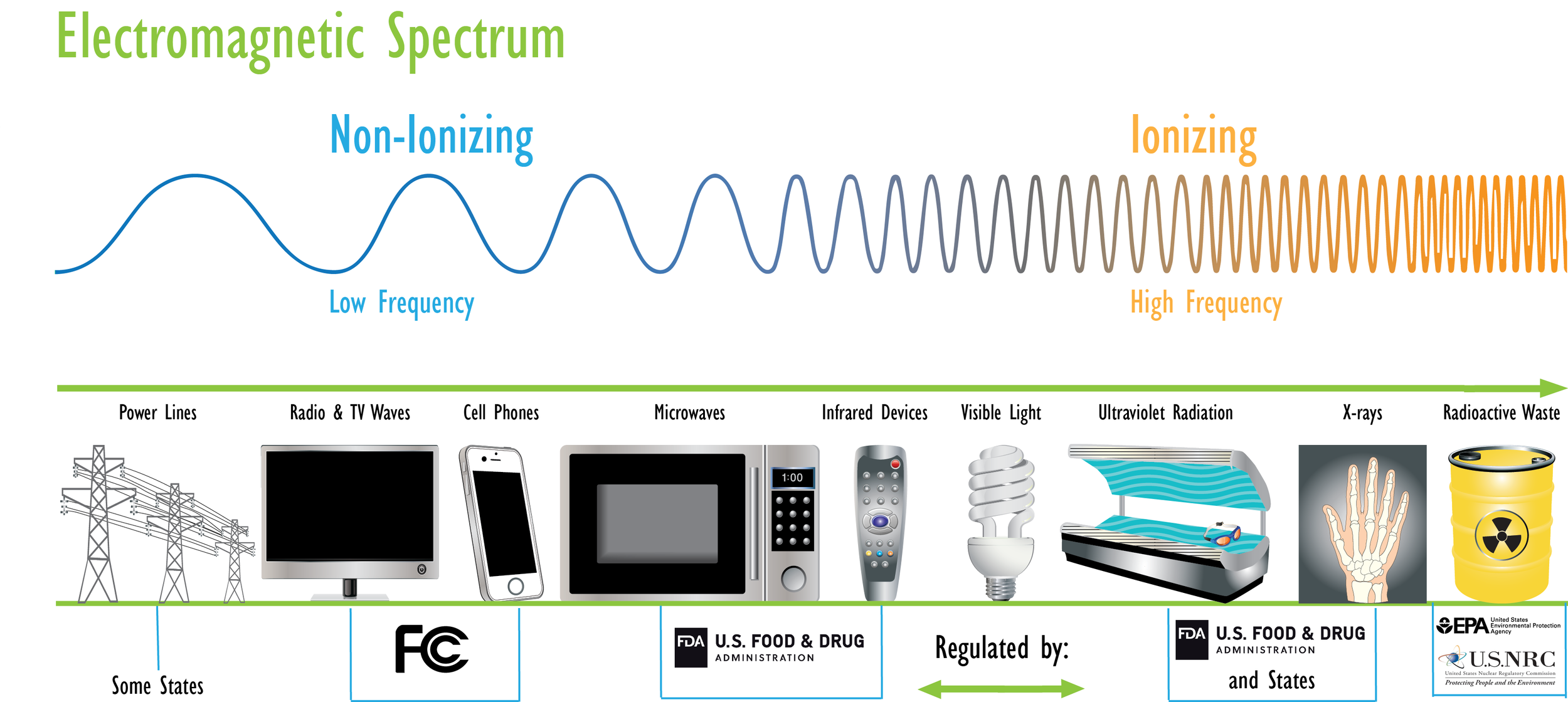
What is radiation?
Radiation is energy in the form of particles or waves traveling through space. Radiation comes in two main forms – ionized and non-ionized. Ionization means that a particle or wave is so high energy that it can break chemical bonds and therefore can give a charge to an atom that interacts with it. Microwaves or radio waves are forms of non-ionized electromagnetic radiation. This form of radiation isrelatively low-energy so it isn’t as harmful as ionized radiation. In large amounts it can cause damage such as burned skin (don’t put yourself in a microwave), but it won’t damage your DNA – there is no conclusive evidence of non-ionized electromagnetic radiation like cell phones or microwaves causing cancer. The bad-boy of radiation is ionized radiation. Ionized radiation has so much energy that it can change the atomic structure of molecules in your body and therefore can damage DNA – which can lead to cancer. The three other main types of ionized radiation are alpha particles (α), beta particles (β), and gamma rays (γ).
The “bad boys” of radiation
Gamma radiation is the classic radiation you think of when you think of nuclear disasters and needing to head to a fallout shelter. I wish I could say that this is the most harmful kind of radiation, but it’s more complicated than that, so it’s important to know the difference between these types of radioactive particles and rays.
- Alpha particles
- Alpha particlesare made up of protons and neutrons from decaying unstable radioactive elements like radium and uranium. They are large, slow moving and can only travel a short distance. Clothing or paper can stop these particles. However the interesting thing about alpha particles is that if they do enter your body through inhalation or ingestion they can cause a lot of damage because they have the highest ionizing power (the power to damage other molecules). Think of an alpha particle as like a steel wrecking ball that got loose and is rolling down a hill damaging everything in its path (your cells). Radon gas exposure is the second leading cause of lung cancer because it is a naturally occurring radioactive gas (it can seep into basements from the decay of radioactive material in the ground). If inhaled over a long period of time, it can cause a lot of damage to the lungs because it emits alpha particles.
- Examples
- Radium-226
- Radon-222

Source: Wikimedia Commons
- Beta Particles
- Beta particles are very middle-of-the-road. They can penetrate some objects and have medium ionization power (remember their ability to cause damage). Think of a beta particle like a bowling ball rolling down a hill and hitting everything in its path. You still don’t want to be in its way. Since beta particles are made up of electrons, they are much smaller than alpha particles. However, because of their smaller size they can penetrate objects, like human skin, but not penetrate all the way through the body. They are still stopped by many solid objects like a ¼ inch thick piece of aluminum. They also can’t travel very far, so if you had some beta emitting lead-212 on your desk (which would be weird but whatever), it would only release beta particles a few feet from the source. If you sat next to it for a while it could cause burns and tissue damage. And yes, an aluminium foil hat would offer some protection for you. Again though, the biggest danger is ingesting these particles in some way through dust or water that contains beta-emitting radionuclides.
- Examples
- Radium-228
- Lead-212
- Examples
- Beta particles are very middle-of-the-road. They can penetrate some objects and have medium ionization power (remember their ability to cause damage). Think of a beta particle like a bowling ball rolling down a hill and hitting everything in its path. You still don’t want to be in its way. Since beta particles are made up of electrons, they are much smaller than alpha particles. However, because of their smaller size they can penetrate objects, like human skin, but not penetrate all the way through the body. They are still stopped by many solid objects like a ¼ inch thick piece of aluminum. They also can’t travel very far, so if you had some beta emitting lead-212 on your desk (which would be weird but whatever), it would only release beta particles a few feet from the source. If you sat next to it for a while it could cause burns and tissue damage. And yes, an aluminium foil hat would offer some protection for you. Again though, the biggest danger is ingesting these particles in some way through dust or water that contains beta-emitting radionuclides.

Source: Wikipedia
- Gamma Rays
- Gamma rays are unique because they are rays (on the electromagnetic spectrum like radio waves and light) and not particles. They are high frequency and high energy with no mass so they can pass right through the human body causing widespread systemic damage (think about the damage to the human body from an atomic bomb). They can only be blocked by a very solid object like several inches of lead. Gamma rays often coincide with alpha and beta particles, so for example Radium-226 emits both alpha particles and gamma rays. Shale is often so high in gamma emitting radionuclides that gamma ray measurements are used to find the presence of shale gas.
- Examples
- Radium-226
- Thorium-232
- Examples
- Gamma rays are unique because they are rays (on the electromagnetic spectrum like radio waves and light) and not particles. They are high frequency and high energy with no mass so they can pass right through the human body causing widespread systemic damage (think about the damage to the human body from an atomic bomb). They can only be blocked by a very solid object like several inches of lead. Gamma rays often coincide with alpha and beta particles, so for example Radium-226 emits both alpha particles and gamma rays. Shale is often so high in gamma emitting radionuclides that gamma ray measurements are used to find the presence of shale gas.

Source: EPA
Important takeaways:
- Exposure to alpha and beta particles can be even more damaging than gamma rays if they are ingested or inhaled.
- Any exposure to ionized radiation can cause cell damage, which can eventually lead to health effects like cancer.


Source: US Department of Energy
How is dosage measured and regulated?
Determining radiation exposure can be complicated because many different factors play into exposure and damage to the human body. The Sievert unit (Sv) measures human exposure to radiation, taking into account the type of radiation, the amount, and the amount of time a person was exposed. When we think of measuring radiation we think of the trusty Gieger counter. The Geiger counter can detect alpha particles, beta particles, and gamma rays. However, getting a proper reading isn’t straightforward and there are many other ways to get more accurate readings. For example, as we learned before, alpha particles can’t penetrate objects and a proper reading could be obscured by everyday materials such as water, dust or any sort of container. So, if someone held a Gieger counter up to a truck full of Radium-226, the alpha particles could not be detected through the truck body. Gamma radiation could potentially be detected through a truck body and there is evidence over the past decade of trucks carrying drilling waste to landfills setting off radiation detectors. However, this is grossly under-reported due to both improper testing and the government, industry, and waste handlers turning a blind eye.
- According to the EPA, risk from exposure to radiation depends on:
- The energy of the radiation it emits.
- The type of radiation (alpha, beta, gamma, x-rays).
- Its activity (how often it emits radiation).
- Whether exposure is external or internal:
- External exposure is when the radioactive source is outside of your body. X-rays and gamma rays can pass through your body, depositing energy as they go.
- Internal exposure is when radioactive material gets inside the body by eating, drinking, breathing or injection (from certain medical procedures). Radionuclides may pose a serious health threat if significant quantities are inhaled or ingested.
- The rate at which the body metabolizes and eliminates the radionuclide following ingestion or inhalation.
- Where the radionuclide concentrates in the body and how long it stays there.
- Federal limits:
- EPA drinking water limit is 5 pCi/L for radium-226 and radium-228
- EPA soil concentration limit in uranium and thorium mill tailings is 5 pCi/g in first 15 cm of soil and 15 pCi/g in deeper soil
- According to the EPA, the average indoor radon level is about 1.3 picocuries per liter (pCi/L)
- The EPA also states that “there is no known safe level of exposure to radon” and recommends homes not exceed radon levels of 4 pCi/L
Important takeaways:
- Measuring radiation exposure and the tools used to measure radiation are not always straightforward and it is possible to get incorrect and skewed results
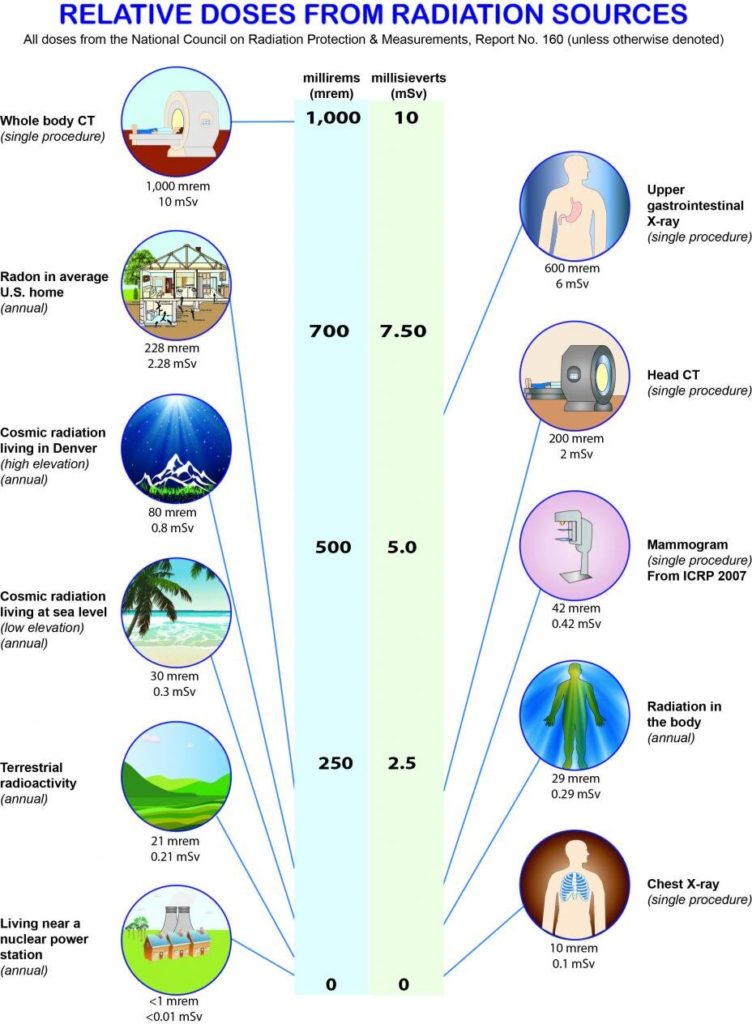
Radioactivity and Human Health
If someone is exposed to a high level of radiation over a short period of time (such as the fallout from an atomic bomb), they will experience acute radiation syndrome or “radiation sickness” and suffer from nausea and vomiting within a few hours of exposure, widespread systemic tissue damage, and often, death within days or weeks. However, exposure to lower amounts of radiation over long periods of time can also be incredibly harmful to the human body. As explained before, alpha and beta particles that are ingested or inhaled are incredibly damaging.
An example of this is the danger of radon-222 (from the uranium-238 decay chain and a direct daughter of radium-226). Relative to other radionuclides, radium is especially water soluble and easily binds to organic material where it has a long half-life (1600 years) and continually breaks down into radon. The half-life of radon-222 is 3.8 days, where it quickly decays again into solid particles such as polonium-218 and later, lead-210 which can lodge in the lungs and emit damaging alpha, beta and gamma radiation. It is important to remember that each time a radionuclide decays it releases its damaging radioactive energy, so particles that decay more quickly are more “radioactive” and damaging. Lead-210 has a half-life of 22 years; if ingested, it can stay lodged in the body releasing radiation for a large portion of a human lifetime. After these particles enter the lungs, they can be absorbed into the blood, other organs, and bones. Another pathway of exposure occurs when the solid decay products of radon-222 (such as lead-210) attach to dust and other particulate matter and fall with rain or become incorporated in the dust of one’s home.

Source: World Nuclear Association
Additionally, radium-226, 228 and radon-222 are referred to as “bone seekers” because the body thinks they are calcium and incorporates the elements into bone tissue. After exposure, about 20% of the elements will end up in your bones and once it attaches to your bones, it stays there. This was all discovered from the “Radium Girls” investigation, where workers in a factory painted watches with radium-laced paint to make them glow in the dark, and the workers fell ill with radiation poisoning and related illnesses.
In Harrison Martland’s 1921 study on the “Radium Girls” titled The Occurrence of Malignancy in Radioactive Persons he explained the nature of the women’s exposure to radium:
“In a radioactive dial painter who has, for example, 10 micrograms of radioactive substances deposited as insoluble sulphates in the entire skeleton, there are constantly being ejected about 370,000 space-occupying alpha particles a second, with a speed approximating 18,000 miles per second. This bombardment, which I have designated as an internal bombardment, is continuous, and will last, for an indefinite period. For instance in the year 3491 A.D., the skeleton will still be giving off 185,000 alpha particles per second.”
While these women did ingest large amounts of radium, it this still shows that alpha particles, and not just gamma rays, can be incredibly damaging.
Radiation exposure is explained in America’s Radioactive Secret by Justin Nobel:
“Breathing in this stuff and ingesting it are the worst types of exposure,” Stolz continues. “You are irradiating your tissues from the inside out.” T
he radioactive particles fired off by radium can be blocked by the skin, but radium readily attaches to dust, making it easy to accidentally inhale or ingest. Once inside the body, its insidious effects accumulate with each exposure. It is known as a “bone seeker” because it can be incorporated into the skeleton and cause bone cancers called sarcomas.
It also decays into a series of other radioactive elements, called “daughters.” The first one for radium-226 is radon, a radioactive gas and the second-leading cause of lung cancer in the U.S. Radon has also been linked to chronic lymphocytic leukemia.
“Every exposure results in an increased risk,” says Ian Fairlie, a British radiation biologist. “Think of it like these guys have been given negative lottery tickets, and somewhere down the line their number will come up and they will die.”
Important takeaways:
- We are all exposed to radiation in our everyday lives, but long-term exposure to low-levels of radiation, such as with inhaling radon, is proven to harmful.
- Ingesting or breathing in alpha-emitting compounds such as radium-226, which can bind to soil or dissolve in water, can potentially be very harmful to the human body.
- Radium and radon exposure is known to cause various cancers, including bone and lung cancer.
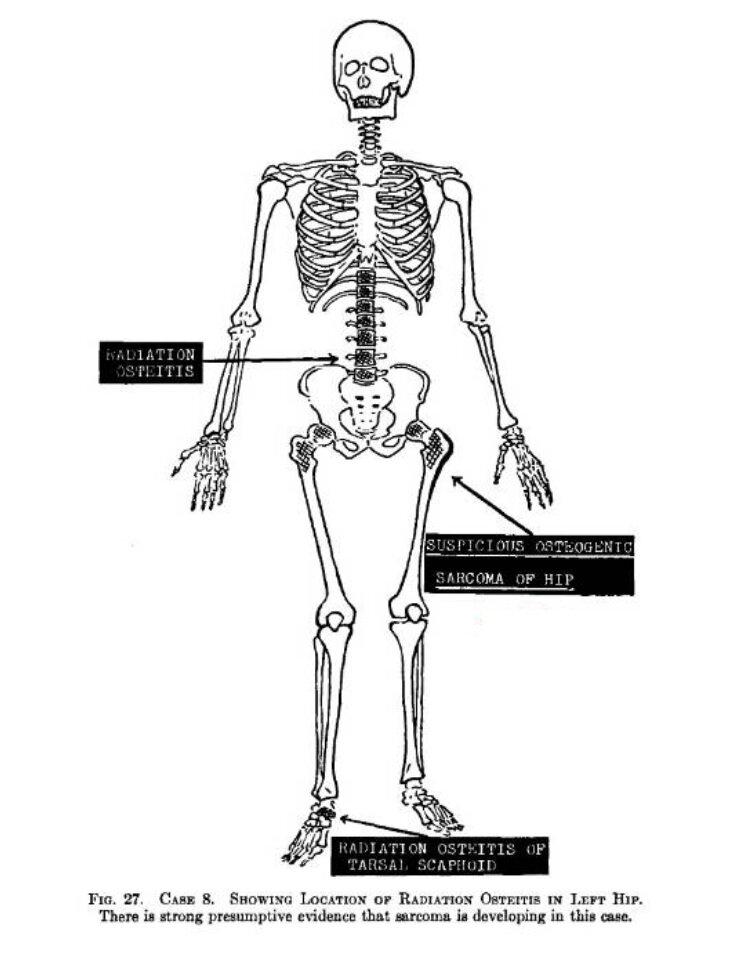
Harrison Martland’s study on radium exposure in 1921: The Occurrence of Malignancy in Radioactive Persons showed evidence of radium being a “bone seeker”
Within the Marcellus Shale is a “Radioactive Stew”
In 1960, the United States Geological Survey released a report on behalf of the US Atomic Energy Commission called Oil Yield and Uranium Content of Black Shales. Why would the Atomic Energy Commission be interested in shale? They were investigating it as a source for uranium. They stated:
- “The amount of uranium in these shales is extremely large, reckoned in billions of tons of metallic uranium. . .”
- “In the course of processing the shale for its uranium, the shale probably would be retorted, and the extracted oil would be a significant byproduct.”
The Marcellus Shale is one of the largest and most productive oil and gas shales in the country, and it also has one of the highest concentrations of radioactive compounds. According to the 2010 study Radioactivity in Marcellus Shale by Dr. Marvin Resnikoff, uranium content in the Marcellus shale was found to be 59.4 pCi/g (compared to a background uranium content of 2.8 pCi/g, making this 20x higher than background levels). This radioactivity is consistently high throughout the shale. Granite, which can also contain radioactive compounds, measures an average of 3.30 pCi/g.
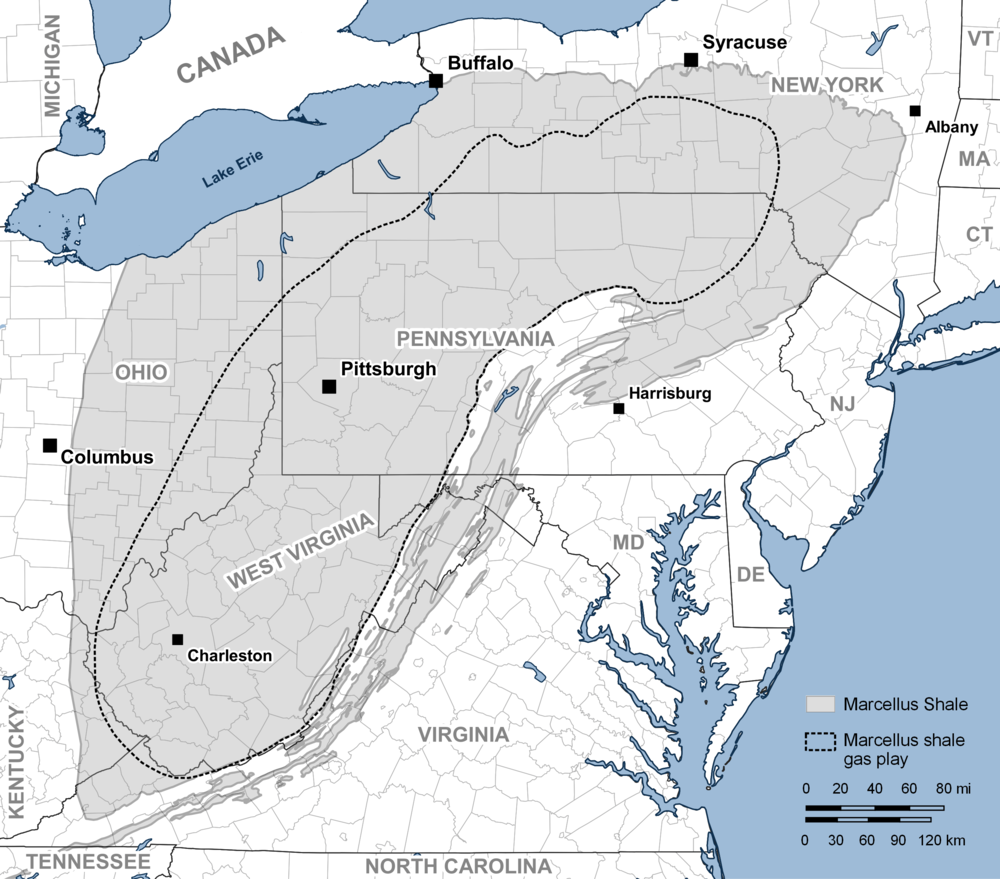
Source: Wikimedia
Where does this radioactivity come from?
All radioactive materials today were created in the very beginning of the universe. This ancient “star dust” and its decay products have been incorporated into earth’s rocks from the very beginning.
The Marcellus Shale was formed from particularly radioactive mud (from sediment of radioactive rocks eroding, mostly uranium and thorium) in shallow seas 350 million years ago.
The brine from the shallow sea that is still locked within the shale along with the oil and gas further concentrates the radium-226 (a daughter of uranium which is less water-soluble) since it can dissolve in water. After being left to sit for 350 million years, this ancient brine is therefore highly concentrated with radioactive compounds.
If you are wondering, coal and especially coal ash can also contain varying levels of NORM/TENORM, but not in as high of concentrations as shale. All fossil fuels can contain NORM.

Source: Wikipedia
According to the World Nuclear Association:
NORM in the oil and gas industry poses a problem to workers particularly during maintenance, waste transport and processing, and decommissioning. In particular Pb-210 deposits and films, as a beta emitter, is only a concern when pipe internals become exposed. External exposure due to NORM in the oil and gas industry are generally low enough not to require protective measures to ensure that workers stay beneath their annual dose limits (such as set out by the IAEA basic safety standards). Internal exposures can be minimized by hygiene practices.
According to the EPA:
TENORM (Technically Enhanced Naturally Occurring Radioactive Material, see definition above) can be found in solids, liquids, sludges and/or gases. It’s possible for TENORM to come from different parts of the oil and gas extraction process. Here are a few examples:

- “Drill cuttings: When drilling for oil and gas, rock is ground into small pieces using a sharp bit. These pieces of rock, called drill cuttings, can contain radioactive elements that are found inside the rock.”
- It has been estimated that 500-1000 tons of drill cuttings can come to the surface per drilled well. For disposal, drill cuttings are often treated as normal rocks/dirt, but in reality they are often coated with drilling fluid and can contain other hazardous compounds such as radioactive material. Drill cuttings are cited for many possible reuses, such as restoring wetlands, stabilizing roads, and brick manufacturing.

- “Flowback and produced water: These terms describe the water that comes back to the surface during and after drilling. Flowback water is the solution that returns to the surface after injecting materials into the well for fracking. Industrial water, sand and chemicals mix with water in the formation to create flowback water. Produced water is the salty liquid that is brought to the surface with oil and gas after the well is developed and put into production.”
- Brine is often misrepresented as “salt water” but in reality there are many other substances dissolved in that water than salt. As stated above, this brine often contains high concentrations of radioactive materials.
- According to the USGS, produced water from the Marcellus Shale in New York was found to have a median radium concentration of 5,490 pCi/L
- Due to the “Halliburton Loophole,” the natural gas industry does not have to disclose what is in their “fracking fluid.”
- Most wastewater is either “treated” and reused or sent to Class II injection wells.
- Until 2011, this produced water was sent to wastewater treatment plants (WWTPs) and then released into streams.
- Now, the waste is not sent to WWTPs but the sludge that settles out of the liquid slurry is classified as solid waste and can be sent to municipal landfills. Leachate that percolates through the landfill is still sent to WWTPs and then discharged into streams. This discharge is usually tested for radionuclides every few years.
- “Pipe scale: When water is pumped in and out of well and storage tanks, a coating called pipe scale builds up around the inside of the pipe. Pipe scale is made up of the natural minerals found in water, which sometimes include radionuclides. Radioactivity in pipe scale can be quite high.”
- “Sludges, sediments, and filters: Sludge is an oily, loose material from produced water that often ends up in water storage tanks. Sediments are the more solid material, often present in water storage tanks. Filters can contain TENORM that is captured as liquid and gas passes through.”
Two other not-so-obvious waste streams result from the “disposal” of this waste:
- Leachate
- As rainwater percolates through a landfill, it picks up chemicals and other products from the waste itself. If landfills accept oil and gas waste, the rainwater will percolate through that potentially hazardous and radioactive material. This leachate is often sent to waste water treatment plants (WWTPs). Many WWTPs do not have adequate resources to properly treat this waste.
- Wastewater effluent
- If oil and gas waste is not injected into underground wells or sent to landfills, it can be sent to facilities to “treat” the waste (and sometimes to extract products like salt for pool salts). The treated water can be released into streams like treated landfill leachate. WWTPs simply do not have the capacity and resources to properly treat this water.
For further reading:
Earthwork’s 2019 Still Wasting Away Report
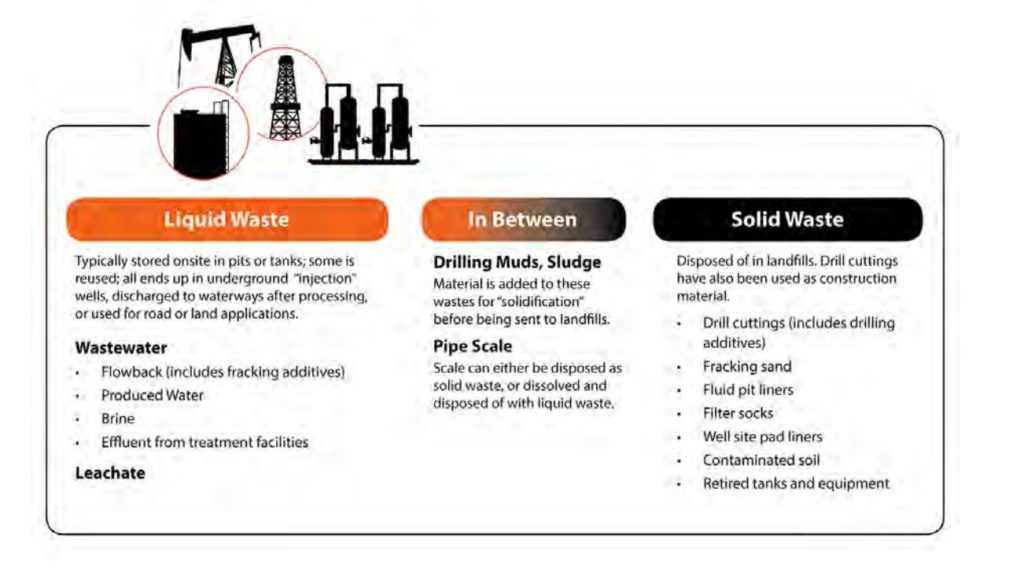
Another important note about waste is that the industry also disposes of it through “beneficial use”. Municipalities use it as a solution for de-icing roads, dust suppression on dirt roads (which is proven not to work for its intended use), spreading sludge on fields, and using drill cuttings as fill for construction and road maintenance. This is yet another example of the industry taking advantage of our communities who are in need of resources and and are unknowing receptacles of their hazardous waste.
According to experts in the field, the waste is being improperly tested in two major ways. First, using a tool such as a Gieger counter to measure gamma radiation from Radium-226 and Radium-228 will not produce an accurate result of the radioactivity, since they produce much more highly alpha and beta (respectively) emitters than gamma emitters. To get a highly accurate reading, one must use a kind of test called “gamma spectroscopy” to take into account not only the radium but the daughter products it decays into (remember, this decay is what is harmful). This takes about 3 weeks to “grow in”, as scientists refer to it, , for the accurate collecting and measuring of daughter products like radon. The government, industry, and regulators are not using this test. To have to wait almost a month to get accurate readings of all the waste would not only be incredibly expensive, but it would give the industry unfavorable results. Secondly, brine is usually improperly tested using what is called the “EPA 900 Series Test,” which was designed to test radionuclides in drinking water – not brine which is a complicated mixture of molecules that can skew the reading (remember that alpha/beta particles will be blocked by many solids).
Takeaways:
- The EPA itself claims most of the waste from fracking is radioactive.
- Dealing with this large amount of waste properly is a major issue for the industry.
- Waste can be injected into the ground, used publicly for “beneficial use”, or sent to landfills.
- This waste is not usually required to be tested for radionuclides, but if it is, it is usually improperly tested.
But the Government Regulates Radioactive Materials…Right?
Long story short: THE MOTHER OF ALL LOOPHOLES
The loophole many people are familiar with is brought to us by the Energy Policy Act of 2005, or as it is commonly known, “The Halliburton Loophole”. This was a massive energy bill containing various policies, but one of the most important was allowing fracking operations to be exempted from key provisions of the Safe Drinking Water Act. Additionally, the bill protected the chemical slurry used in fracking as a “trade secret” (akin to Coca-Cola’s secret flavors) that didn’t need to be regulated by the EPA.
A lesser known loophole deals not with what the industry is putting in the ground, but what it needs to do with what it is taking out.
In 1976, the Resource Conservation and Recovery Act (RCRA) was passed, giving the EPA the authority to control hazardous waste for the whole lifecycle of the product, “cradle to grave”.
In 1988, the EPA chose to exempt oil and gas waste from the RCRA despite also saying that it does, indeed, contain toxic substances.
“For crude oil and natural gas wastes, EPA sampled liquids and sludges from several locations. Drilling fluids were sampled at drilling operations while produced water and tank bottoms were sampled at production operations. Samples from central treatment and disposal facilities and central pits contained mixtures of all wastes including associated wastes. The Agency found that organic pollutants at levels of potential concern (levels that exceed 100 times EPA’s health-based standards) included the hydrocarbons benzene and phenanthrene. Inorganic constituents at levels of potential concern included lead, arsenic, barium, antimony, fluoride, and uranium.”
“EPA’s review of the third factor found that imposition of Subtitle C regulations for all oil and gas wastes could subject billions of barrels of waste to regulation under Subtitle C as hazardous wastes and would cause a severe economic impact on the industry and on oil and gas production in the U.S. Additionally, because a large part of these wastes is managed in off-site commercial facilities, removal of the exemption could cause severe short-term strains on the capacity of Subtitle C Treatment, Storage, and Disposal Facilities (TSDFs), and a significant increase in the Subtitle C permitting burden for State and Federal hazardous waste programs.”
Thus, according to the EPA: Because the waste is such an expansive problem, the industry could not exist as we know it without this exemption. If you don’t acknowledge the waste as hazardous, then you don’t need to treat it as such. Therefore, regulation was put into the hands of the states whose hands were already tied by these powerful industries. In Pennsylvania, the federal exclusion of oil and gas waste being treated as hazardous waste is also incorporated into state law.
The industry is largely left to regulate itself and its waste stream. It is up to oil and gas operators and waste disposal facilities to define the waste as either hazardous or not, and to dispose of it properly.
But at least workers are protected, right?
The EPA considers NORM from oil and gas activity to be a hazard to workers:
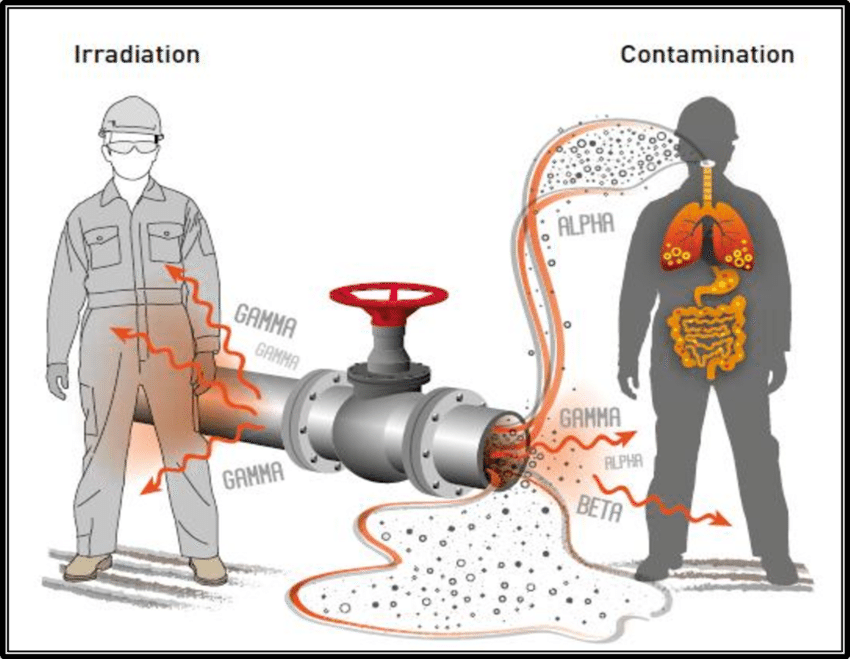
“Potential risks assessed for these workers include inhalation of radioactive dust and direct exposures to gamma radiation. In addition, they may inhale radon gas which is released during drilling and produced by the decay of radium, raising their risk of lung cancer.”
In the North Sea, oil rig workers are considered to be “radiation workers” and are given appropriate protections.
Yet, workers in the US are rarely, if ever, given proper training or information on this issue. Furthermore, even if they have this information they often don’t have other options for a decent job.
Wait, so where is the waste going?

Both maps listed below are incredibly helpful resources for visualizing the oil and gas waste stream:
- “Facilities Accepting Pennsylvania’s O&G Waste between 2011 and 2018” by Earthworks and Fractracker
- “How Radioactive Fracking Waste Gets in Pennsylvania Waterways” by Public Herald and FracTracker
Some liquid waste is sent to centralized waste treatment plants (CWT) to be treated for recycling in the oil and gas industry or to be discharged into streams. According to the 2016 DEP TENORM Study Report, the soil at the outfalls of these CWTs were found to have numbers as high as 508 pCi/g (the EPA limit for uranium mill site soil is 5 pCi/g). Much of the waste is sent to municipal landfills who are woefully inadequate for handling such large amounts of low-level radioactive waste. Between 2011 and 2018, the Arden Landfill in Washington County has taken some of the largest amounts of Marcellus drilling waste in the state – about 1,253,035 tons of solid waste. That’s the weight of about 417,678 pickup trucks – which is still hard to comprehend just how much waste that is. Often this waste is used as a convenient “daily cover” for landfills instead of topsoil to cover the garbage. This not only exposes workers and local residents to the dust and possible radon coming off the waste, but it creates a “layer cake” of low level radioactive waste as the landfill grows and water percolates through it. According to Dr. Marvin Resnikoff in a report from 2010 titled Radioactivity in Marcellus Shale:
Radium-226 has a half-life of 1600 years and, if deposited in the landfill, will remain there essentially forever. Landfill workers that come in contact with the contaminated materials may be exposed. Further, if the landfill is ever inhabited in the future, crops grown in the soil will concentrate radium and be ingested. Ra-226 is a carcinogen and, when ingested or inhaled, concentrates in the bone and can cause leukemia. As we noted in our April 7 memorandum, at page 4, exposures to landfill workers and those who eat fruits or vegetables grown more than 1,000 years in the future over the closed landfill would exceed current health-based dose limits.
Meanwhile, only four facilities in the country are actually capable of handling this radioactive waste. As rain enters landfills, it percolates through the waste, picking up other liquids and nasty stuff along the way, and then is collected from the landfill as “leachate.”. This leachate is sent to waste water treatment plants to be “treated”. The RCRA has a clever “domestic sewage exclusion” which state that if liquid wastes are mixed with sewage, they don’t fall under the RCRA (if they did, they would have to be treated as hazardous waste), but rather the Clean Water Act. The Clean Water Act is meant to protect public waterways from industrial pollution; any sources of pollution require a National Pollutant Discharge Elimination System (NPDES) permit. Yet, within NPDES there is no regulation on releasing NORM/TENORM materials into waterways. So WWTPs don’t have the capacity and tools to deal with this waste since they aren’t meant to, and they aren’t required to test for it. Again – if you don’t regulate it, you can act like it isn’t there.
Furthermore, Radon and Lead-210 can present pathways through burning the gas at the frack pad or in your home, gas leaking from compressor stations and pipelines, landfill off-gassing, particulates entering the atmosphere and falling as rain, and other pathways we don’t yet fully understand. Another potential very hazardous pathway is the pipes from the drilling process, which need to be replaced after a decade or so because they build up scale (like your hard water pipes do at home), which is highly radioactive.
The EPA says risks of TENORM to “nearby residents/office workers” within 100 meters of a disposal site includes:
- Direct gamma radiation
- Inhalation of contaminated dust
- Inhalation of downwind radon
- Ingestion of contaminated well water
- Ingestion of food contaminated by well water
- Ingestion of food contaminated by dust deposition
Remember that any exposure to these radionuclides can be dangerous.
The EPA also says:
“The problem of TENORM contamination is now known to be widespread, occurring in oil and gas production facilities throughout the world. It has become a subject of attention in the United States and in other countries. In response to this concern, facilities in the U.S. and Europe have been characterizing the nature and extent of TENORM in oil and gas pipe scale, evaluating the potential for exposure to workers and the public, and developing methods for properly managing these low specific-activity wastes.”
I used to naively believe that our regulatory system was one based on preventing harm to the environment and human health. The truth is, it is not about preventing harm but it is rather regulating the amount of harm caused.
Takeaways:
- Government agencies have simply passed the baton around to deal with TENORM from oil and gas waste. They have utterly failed to properly protect our environment, workers and the public.
- The industry has failed at “self regulating” in a safe way.
What can we do?
Our system does not need to be based on harm and profit above human life. Furthermore, it is a lie told by the fossil fuel industry that an end to fossil fuels would mean the end of economic growth, good jobs, well-being, and all the convenient things of modern society. It’s not wishful thinking to say that we can value human dignity and the environment while also having a healthy economy of abundance.
It doesn’t have to be this way.
Demand accountability from the oil and gas industry and our government.
CCJ will continue to fight for healthy, safe and prosperous communities in Washington and Greene Counties.

Further reading:
Articles:
- World Nuclear Association: Naturally Occurring Radioactive Materials
- Rolling Stone: America’s Radioactive Secret
- Public Herald: Radioactive Rivers
- Public Herald: Government Failed You
- Earthworks: Still Wasting Away Report
- Post-Gazette: Belle Vernon sewage plant to stop accepting contaminated landfill runoff
- DeSmog Blog: 1982 American Petroleum Institute Report Warned Oil Workers Faced ‘Significant’ Risks from Radioactivity
- New York Times: Regulation Lax as Gas Wells’ Tainted Water Hits Rivers
- Public Integrity: States Struggle to deal with Radioactive Fracking Waste
- Environmental Advocates of New York: License to Dump Report
- FracTracker: Fracking in Pennsylvania in 2019
- FracTracker: Want Not, Waste Not? Fossil Fuel Extraction’s Waste Disposal Challenges
Documents:
- (1944) Distribution of Radioactivity in Ancient Sediments
- (1960) Oil Yield and Uranium Content of Black Shales
- (1981) Geochemistry of trace elements and uranium in Devonian shales of the Appalachian Basin
- (1990) Radioactive Materials Could Pose Problems for the Gas Industry
- (1982) API Analysis of RADIONUCLIDES in oil and gas industry
- (1991) PA DEP NORM Survey Summary
- (1993) NORM Contamination in the Petroleum Industry
- (1999) Naturally Occurring Radioactive Materials (NORM) in Produced Water and Oil-Field Equipment— An Issue for the Energy Industry
- (2010) Radioactivity in Marcellus Shale
- (2011) Radium Content of Oil- and Gas-Field Produced Waters in the Northern Appalachian Basin (USA): Summary and Discussion of Data
- (2013) Occupational Exposures to Radioactive Scale and Sludge
- (2014) Matrix Complications in the Determination of Radium Levels in Hydraulic Fracturing Flowback Water from Marcellus Shale
- (2014) Radionuclides in Fracking Wastewater: Managing a Toxic Blend
- (2015) Review of Pennsylvania Department of Environmental Protection Technologically Enhanced Naturally Occurring Radioactive Materials (TENORM) Study Report
- (2015) WV DEP Examination of Leachate, Drill Cuttings and Related Environmental, Economic and Technical Aspects Associated with Solid Waste Facilities in West Virginia
- (2016) PA DEP TENORM Study Report (2016 update)
- (2018) Sources of Radium Accumulation in Stream Sediments near Disposal Sites in Pennsylvania: Implications for Disposal of Conventional Oil and Gas Wastewater
- (2018) Accumulation of Marcellus Formation Oil and Gas Wastewater Metals in Freshwater Mussel Shells
- (2019) EPA Study of Oil and Gas Extraction Wastewater Management Under the Clean Water Act
Podcasts:
- A Dangerous Secret That Could End Fracking
- “Government Failed You” — Pittsburgh State Rep. Drafts Bill to Stop Radioactive Fracking Waste (TENORM) From Entering Public Waters
- Pennsylvania is Discharging Radioactive Fracking Waste Into Rivers As Landfill Leachate, Impacting The Chesapeake Bay & Ohio River Watersheds
Videos:
- How Fracking Works
- Is Radiation Dangerous?
- Types of Nuclear Radiation
- Radioactive Dangers of Fracking: Dr. Ian Fairlie
- Shale Waste Disposal Forum
- RADIOACTIVE Ten Mile Creek in Pennsylvania
- Radiation in Greene County creeks
Films:
Note: As this is a developing story, this resource will continue to be updated
Most recent update: 3/5/20
